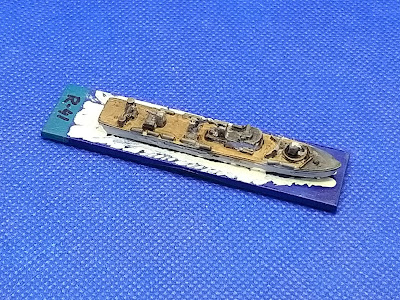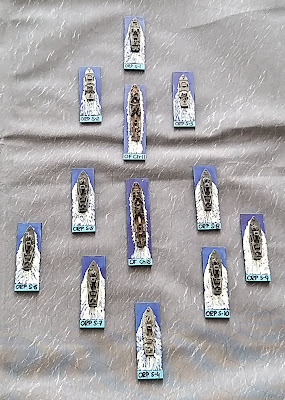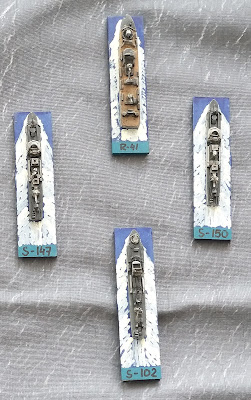Some times ago Campbell told me, that he is going to buy some ships in 1/600 scale from an American company called PT Dockyard. A quick view into their offer and I find that I would almost recreate the whole boats that were part of the Polish Navy during the Second World War. Order was made (actually I added my order to Campbell's one), few weeks awaiting and here you are. Completed models! To make wee ships playable I asked Campbell to add some random German boats, and here you are they are ready for a game. For boat's bases, I used those made by Warbases.
Jakiś czas temu Campbell pobatwiedział mi, że zamierza kupić kilka ścigaczy od amerykańskiego producenta PT Dockyard w skali 1/600. Szybki wgląd w ich ofertę przekonał mnie, że mógłbym odtworzyć prawie wszystkie ścigacze, użyte przez Polską Marynarkę Wojenną w drugiej wojnie światowej. Złożyłem więc zamówienie (właściwie, to dołączyłem do zamówienia Campbella), kilka tygodni oczekiwania i oto one. Gotowe modele! By małe okręciki zrobić bardziej grywalne, poprosiłem Campbella by dodał mi kilka niemieckich ścigaczy i w ten sposób stały się one gotowe do gry. Jako podstawek użyłem produktów Warbases.
ORP S-1
Just before the Second World War, the Polish Navy ordered in the UK 2 MTBs. Its construction was postponed at the outbreak of war. However, after some changes in the project, both boats were finished by J. Samuel White shipyard in Cowes as MA/SB 47 and MA/SB 48 (in January 1941 it was changed into MTB 47 and MTB 48). The second one was taken by Poles and the first was given to the British in exchange for two smaller boats (type British Power Boat 63'). In October 1940 she entered the service. On the second day, during the sea trials, the fire broke out and has to return to the shipyard. After the renovation, the boat was returned to service in January 1941 and stayed in first-line (in 3rd MGB Flotilla of the Royal Navy) till February 1944 and then put into 1st reserve and in April 1944 into the 2nd reserve. After the war, The Poles relinquished the rights to the boat, which most likely was scrapped immediately.
Tuż przed wybuchem drugiej wojny światowej polska MW zamówiła w Wielkiej Brytani dwa ścigacze artyleryjsko torpedowe. Ich budowa została jednak wstrzymana zaraz po wybuchu wojny. Jednakże po kilku zmianach w projekcie, oba okręty zostały wybudowane przez stocznię J. Samuel White w Cowes jako MA/SB 47 i MA/SB 48 (oznaczenia te zostały zmienione w styczniu 1941 na MTB 47 i MTB 48). Drugi z tych okrętów został przejęty przez Polaków a pierwszy oddany Brytyjczykom w zamian za dwa mniejsze ścigacze typu British Power Boats 63'. W październiku 1940, ORP S-1 wszedł do służby. Drugiego dnia w czasie prób morskich na okręcie wybuchł pożar, w wyniku czego powrócił do stoczni. Po remoncie wszedł w skład 3rd MGB Flotilla of the Royal Navy (styczeń 1941). W pierwszej linii do lutego 1944 a w kwietniu 1944 przeniesiona do drugiej rezerwy. Po wojnie Polacy zrzekli się praw do okrętu, który najprawdopodobniej został od razu zezłomowany.
OORP S-2, S-3
Both boats were initially built for Norway and Sweden. They were British Power Boat 63' type. Both of them were given to Poles in exchange for one of the S-1 type. ORP S-2 (MA/SB 44, MTB 44) and ORP S-3 (MA/SB 45, MTB 45) entered the service in July 1940 as a part of the 3rd MGB Flotilla as their 3rd Squadron (later ORP S-1 joined that unit as well). On August 27th, 1941, ORP S-2 shot down a German He-111 bomber. Both ships were part of the cover of the British battleship HMS Revenge when it shelled Cherbourg on September 23rd, 1941. On the night of June 21-22, ORP S-2 fought alone against six German Schnelboots, which ware forced to withdraw. For this action, the commander of the ship, Lieutenant Wciślicki, was awarded the Silver Cross of Virtutti Militari and Distinguished Service Cross. After that ORP S-2 took part in skirmishes with German boats several times and in July 1944 was withdrawn into reserve. In 1947, she was returned to Royal Navy and most likely scrapped afterwards. ORP S-3 was a much more unlucky ship, it still struggled with failures and even hit a mine once. For this reason, it was returned to the Royal Navy in May 1943. The ship was sold to a private owner in 1945 and probably survived until the end of the 1980s. ORP S-3 was replaced by ORP S-4.
Oba okręty były początkowo budowane dla Norwegii i Szwecji. Były typu British Power Boat 63'. Oba zostały przekazane Polakom w zamian za jeden okręt typu S-1. ORP S-2 (MA/SB 44, MTB 44) i ORP S-3 (MA/SB 45, MTB 45) weszły do służby w lipcu 1940 roku jako część 3. Flotylli MGB jako jej 3 dywizjon (później dołączył do oddziału ORP S-1). 27 sierpnia 1941, ORP S-2 zestrzelił niemiecki bombowiec He-111. Oba okręty stanowiły część osłony brytyjskiego krążownika liniowego HMS Revange, gdy ten ostrzeliwał Cherbourg 23 września 1941 roku. W nocy z 21 na 22 czerwca ORP S-2 samotnie stoczył bój z sześcioma niemieckimi Schnelbootami, które zmusił do wycofania się. Za tą akcję dowódca okrętu porucznik Wciślicki został odznaczony Krzyżem Srebrnym Virtutti Militari i Distinguished Service Cross. Potem jeszcze kilkukrotnie ORP S-2 brał udział w potyczkach z niemieckimi ścigaczami i w lipcu 1944 został wycofany do rezerwy. W 1947 roku zwrócony Royal Navy i najprawdopodobniej wkrótce zezłomowany. ORP S-3 było dużo bardziej pechowym okrętem, wciąż borykał się z awariami a nawet raz wszedł na minę. Z tego powodu został zwrócony Royal Navy w maju 1943. Okręt ten w 1945 został sprzedany prywatnemu właścicielowi i prawdopodobnie dotrwał do końca lat 80. ORP S-3 został zastąpiony przez ORP S-4.
ORP S-4
ORP S-4 (MGB-113, from November 1943 MGB 432) was British Power Boat 71'6'' type. In Royal Navy service since December 1942. She entered the Polish service in July 1943 as the replacement for ORP S-3. She joined the 9th MGB Flotilla. Her torpedo tubes were removed before she entered Polish service and never fitted back. In January 1944 the ship ran aground and therefore had to undergo renovation. Then it was decided to hand over the ship to the Dutch Navy, which took place in April 1944. She was never put into active service and was returned to Royal Navy in September 1944. Further fate is unknown, she was probably sold to a private investor.
ORP S-4 (MGB-113, od listopada 1943 MGB 432) była ścigaczem typu British Power Boat 71'6'. W służbie Royal Navy od grudnia 1942. W służbie PMW od lipca 1943 jako zastępstwo za zwrócony ORP S-3. Dołączył do 9. Flotylli MGB. Jego wyrzutnie torpedowe zostały usunięte przed przejęciem przez PMW i nigdy z powrotem nie zamontowane. W styczniu 1944 okręt wszedł na mieliznę i musiał przejść remont. W jego czasie (kwiecień 1944) okręt przekazany Marynarce Wojennej Holandii. Nie został jednak postawiony w pierwszej linii i we wrześniu 1944 okręt zwrócono Royal Navy. Dalsze losy nie są znane, najprawdopodobniej sprzedany prywatnemu inwestorowi.
OORP S-5, S-6, S-7, S-8, S-9, S-10
In 1943 J Samuel White Shipyard in Cowes made 6 new motor torpedo boats of modified Vosper1943 project. All of them were given to Polish Navy as OORP S-5 (MGB 424), S-6 (MGB 425), S-7 (MGB 426), S-8 (MGB 427), S-9 (MGB 428) and S-10 (MGB 429). They entered Polish service between May and October 1944. All boats seen not many actions as the combat operations in the English Channel slowly stopped during this period. At the end of 1944 from all boats has been removed the torpedo tubes. All boats were returned to Royal Navy in October 1945.
W 1943 stocznia J Samuel White w Cowes zbudowała serię 6 nowych ścigaczy torpedowych, będącą modyfikacją typu Vosper 1943. Wszystkie zostały przekazane PMW jako OORP S-5 (MGB 424), S-6 (MGB 425), S-7 (MGB 426), S-8 (MGB 427), S-9 (MGB 428) i S-10 (MGB 429). Do służby weszły pomiędzy majem a październikiem 1944 roku. Wszystkie okręty nie wzięły udziału w wielu działaniach bojowych ze względu na wygasanie walk na Kanale La Manche w tym okresie. Pod koniec 1944 roku ze wszystkich okrętów zdemontowano wyrzutnie torpedowe. Wszystkie okręty zostały zwrócone Royal Navy w październiku 1945 roku.
OOF Ch11, Ch15
After the capitulation of France in 1940, Royal Navy took several French ships. Some of them were given to Polish Navy in July 1940. However, the ships were not directly incorporated into the Polish Navy but functioned as leased ships, so they all had the prefix OF, meaning French Ship (Okręt Francuski), before their name. The Poles received 1 destroyer (Ouragan), 2 patrol ships (Medoc and Pomerol) and 2 submarine chasers (Ch 11 and Ch 15). There were also plans to take over the battleship Paris, but this one was beyond the Polish Navy staffing range. Both ships were used by Poles between July 1940 and February 1941 and then returned to Free French Navy. They made many patrols but never entered into contact with the enemy.
Po kapitulacji Francji w 1940 roku, Royal Navy przejęła część okrętów francuskich. Niektóre z nich zostały przekazane PMW w lipcu 1940. Jednak, okręty nie zostały bezpośrednio wcielone do PMW a funkcjonowały jako okręty w dzierżawie, stąd wszystkie miały przed nazwą prefiks OF, co znaczy Okręt Francuski. Polacy otrzymali 1 niszczyciel (Ouragan), 2 okręty patrolowe (Medoc i Pomerol) i 2 ścigacze okrętów podwodnych (Ch 11 i Ch 15). Były również plany przejęcia pancernika Paris, ale ten był poza kadrowym zasięgiem PMW. Oba okręty były używane przez Polaków pomiędzy lipcem 1940 a lutym 1941 i zostały zwrócone Marynarce Wolnych Francuzów. Wykonały kilkadziesiąt patroli, jednak nigdy nie weszły w kontakt z wrogiem.
I'm still missing two ships, mentioned OF Medoc and OF Pomerol to have all ships used by Poles. Unfortunately, they are unavailable on this scale or I don't know the producer. If I find them I will make them as well.
Wciąż brakuje mi dwóch okrętów, wspomnianych OF Medoc i OF Pomerol by mieć wszystkie, używane przez Polaków. Niestety nie są one dostępne w tej skali, albo ja o tym nie wiem. Jeśli je znajdę, to na pewno je wykonam.
GERMAN SHIPS.
Campbell chose me 4 German boats. 3 Schnelboots, one of type S-38 (S-102) and two of type S-100 (S-147 and S-150) and 1 Raumboot of type R-41 (R-41). The names chosen for them were to fit the area, so they could be the possible opponent to my Polish boats. Sadly I have no information about the fate of that boats.
Campbell wybrał dla mnie 4 niemieckie okręty. Trzy schnelbooty, jeden typu S-38 (S-102) i dwa typu S-100 (S-147 i S-150) oraz jednego raumboota typu R-41 (R-41). Nazwy zostały tak wybrane, by trafić w obszar ich działania i mogły być potencjalnym przeciwnikiem dla moich polskich okrętów. Niestety nie posiadam informacji dotyczących losów tych jednostek.












Very cool ships/boats, Bartek! Nice variety of forces.
OdpowiedzUsuńThank you.
UsuńFantastyczna robota I dzięki za rys historyczny!
OdpowiedzUsuńDziękuję i proszę bardzo.
Usuń